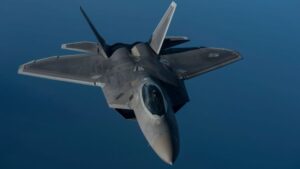The A-1 Skyraider, a seemingly outdated propeller plane, stands out among the sleek jets that dominated the skies of the 20th century. Yet, this “Spad” or “Able Dog,” as pilots affectionately nicknamed it, carved a unique path in military aviation history, proving its worth from the Korean War to the jungles of Vietnam.
But how did this unglamorous aircraft become such a legend?
The A-1 Skyraider’s Unexpected Legacy
Born in the dying embers of World War II, the A-1 Skyraider wasn’t intended for the jet age.
Renowned military aircraft designer Ed Heinemann of Douglas Aircraft Company created the aircraft with the initial concept of filling a gap for the US Navy: a carrier-based bomber capable of handling both torpedo attacks and precision dive bombing.
When the prototype, then called the XBT2D-1, took flight and entered Navy evaluation in 1945, Japan surrendered, rendering its initial purpose obsolete. The test pilots at the Navy Proving Ground, however, rated the aircraft higher than any other dive-bomber they had tested.
A Douglas XBT2D-1 Skyraider prototype, 1946. (Wikimedia Commons)
By December 1946, the rechristened AD-1 Skyraider finally saw its first deployment with VA-19A (formerly Attack Squadron 194), a Navy fleet squadron. There, the unassuming aircraft was discovered to possess hidden talents “and no aviator that flew one then and later would forget the experience of taking to the air for the first time,” noted the National Naval Aviation Museum.
Its robust design, powerful Wright R-3350 engine, and exceptional payload capacity of around 14,491 pounds made it a perfect candidate for a new role—close air support.
The Skyraider’s ability to loiter for extended periods and deliver a devastating punch of ordnance would prove invaluable in future conflicts.
The A-1 Skyraider, a seemingly outdated propeller plane, stands out among the sleek jets that dominated the skies of the 20th century. Yet, this “Spad” or “Able Dog,” as pilots affectionately nicknamed it, carved a unique path in military aviation history, proving its worth from the Korean War to the jungles of Vietnam.
But how did this unglamorous aircraft become such a legend?
The A-1 Skyraider’s Unexpected Legacy
Born in the dying embers of World War II, the A-1 Skyraider wasn’t intended for the jet age.
Renowned military aircraft designer Ed Heinemann of Douglas Aircraft Company created the aircraft with the initial concept of filling a gap for the US Navy: a carrier-based bomber capable of handling both torpedo attacks and precision dive bombing.
When the prototype, then called the XBT2D-1, took flight and entered Navy evaluation in 1945, Japan surrendered, rendering its initial purpose obsolete. The test pilots at the Navy Proving Ground, however, rated the aircraft higher than any other dive-bomber they had tested.
A Douglas XBT2D-1 Skyraider prototype, 1946. (Wikimedia Commons)
By December 1946, the rechristened AD-1 Skyraider finally saw its first deployment with VA-19A (formerly Attack Squadron 194), a Navy fleet squadron. There, the unassuming aircraft was discovered to possess hidden talents “and no aviator that flew one then and later would forget the experience of taking to the air for the first time,” noted the National Naval Aviation Museum.
Its robust design, powerful Wright R-3350 engine, and exceptional payload capacity of around 14,491 pounds made it a perfect candidate for a new role—close air support.
The Skyraider’s ability to loiter for extended periods and deliver a devastating punch of ordnance would prove invaluable in future conflicts.
Earning Respect in the Korean War
The Korean War became the proving ground for the AD-1 Skyraider. While facing heavy losses due to intense ground fire, the “Spad” earned the respect of troops on the ground.
Its low-speed agility and ability to rain down fire on enemy positions made it a crucial asset, and this love affair with ground forces continued into the Vietnam War.
Since its introduction on May 5, 1945, a staggering 3,180 Skyraiders have been manufactured over 12 years, concluding in September 1957. These aircraft were diversified into eight main models (including the XBT2D prototype and AD-1s to 7s) and 37 distinct versions.
A US Navy Douglas AD-1Q Skyraider used for electronic countermeasures, circa 1950. (Wikimedia Commons)
The Skyraider served not only in the Navy but also in Marine squadrons, where it cemented its critical role in close air support missions. Its capacity to take off with hefty ordnance loads was a key factor in its effectiveness.
With this, the Skyraider earned high praise from combat crews, often described as “the best and most effective close-support aircraft in the world” and “the most versatile, single-engine aircraft ever to go into service.”
By 1964, the Marine Corps had fully transitioned its tactical squadrons to the jet-powered A-4 Skyhawk as its close-support aircraft, while the Navy continued to rely on the propeller-driven Skyraider.
To align with a Department of Defense-wide aircraft designation overhaul in 1962, the Navy renamed its Skyraider models. The AD-5, AD-6, and AD-7 variants were subsequently designated as the A-1E, A-1H, and A-1J, respectively.
The Workhorse of American Airpower in Vietnam
While jet fighters captured the public’s attention, the A-1 Skyraider, now with a new designation, continued to be the backbone of American airpower.
The US Air Force joined the Navy in utilizing this versatile aircraft to fulfill a counterinsurgency role. The first Air Force Skyraiders, two-seat A-1E models, arrived at Bien Hoa Air Base in South Vietnam in May 1964. These initial aircraft were assigned to the 1st Air Commando Squadron, known by the call sign “Hobo.”
A-1 Skyraider’s ability to operate from rudimentary airfields and deliver pinpoint attacks on Viet Cong positions was unmatched. Not to mention how the aircraft excelled in the perilous role of search and rescue, its slow speed and long endurance allowing for better spotting of downed pilots.
Perhaps one notable mission—one of the most daring and heroic missions involving the A-1 Skyraider during the Vietnam War, was undertaken by Air Force Major Bernard F. Fisher.
To briefly recall Fisher’s heroism: In 1966, driven by a profound sense of loyalty to his downed and stranded wingman, Major “Jump” Myers, Fisher defied orders and risked his own life to rescue Myers from the besieged A Shau Special Forces Camp. Braving withering enemy fire, Major Fisher landed his aircraft on the heavily damaged runway. Despite being struck more than nineteen times, he managed to taxi and complete the rescue mission. His actions that day earned him the Medal of Honor, a testament to his extraordinary courage and selfless sacrifice.
RVNAF A-1E Skyraider during an airshow. (Wikimedia Commons)
Beyond its primary role in fire suppression, the A-1 often served as a crucial defender of threatened outposts, and by 1973, all A-1s had been transferred to the South Vietnamese Air Force (VNAF).
Following the fall of South Vietnam in April 1975, most of these aircraft were destroyed, marking the end of the Skyraider’s combat career.
A Legacy of Versatility and Ruggedness
In a world increasingly dominated by sleek, supersonic jets, the A-1 Skyraider has become a timeless, tangible proof of the indomitable human spirit and the enduring power of ingenuity.
Its propeller-driven design, though seemingly antiquated, proved remarkably adaptable, transforming the aircraft from a relic of war into an indispensable tool of combat. It was about the closest thing we had to a flying tank at the time.
More than just a machine, the Skyraider became a symbol of unwavering support for those on the ground, a guardian angel in the skies. Its legacy is a reminder that true strength often lies not in technological advancement alone, but in the heart and soul of those who operate it.
—
Disclaimer: SOFREP utilizes AI for image generation and article research. Occasionally, it’s like handing a chimpanzee the keys to your liquor cabinet. It’s not always perfect and if a mistake is made, we own up to it full stop. In a world where information comes at us in tidal waves, it is an important tool that helps us sift through the brass for live rounds.



